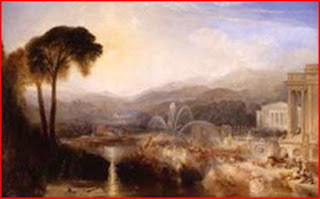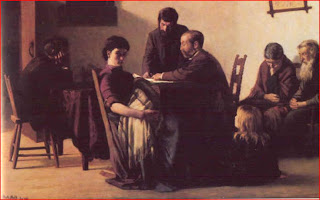
Mo Bayliss is a unique artist. While most artists fit into well defined slots, Mo has made a niche for herself. Or should I say, she has found a niche which has been around for a very, long time.
Mo draws from her personal resource, of her great grandmother's native heritage, and from her love of drawing and her fascination with fossil collecting. But this is only the beginning.
It all started with her providing research and proofreading assistance for the Pecos Rio Grande Museum of Early Man (a virtual online museum based on archaic artifact recoveries from West Texas cave shelters). This led Mo to try her hand at other early historical native crafts and upon telling the Curator she would like to try the paint, he sent along some paint making stones recovered from a cave shelter. Three historical facilities have since come on board, and they have officially recognized her as an amateur archealogist.
Mo became an artist in residence at the Museum of the Boyne, in Alliston Ontario, in April 2006. It was here that she presented her historical illustrations of ancient pottery and heritage watercraft, and she remained there through to November 07.
Mo then programmed and launched the 1st Aboriginal Festival at the Gibson Centre of Alliston, with "Clay - The Aboriginal Way" (on a volunteer basis) in June 2008, and she co-ordinated "One Spirit-Many People" the 2nd in June 2009. Mo reports that she will become the creative director of the forthcoming 2011 Aboriginal Way show.
Mo has packed a lifetime of study and hard work into her last 6 years. What she lacks in formal art education she has supplemented with hard work and instruction from her portrait mentor, Toronto artist Jozef Milczarski who was quick to recognize her natural talent.
And, to make it all the better, Mo has found a market and a home for her art. She has sold over 100 of her works, in the past four years and her collection is displayed at 'Art Unique', a small private gallery in the Cookstown, area of Ontario.
While most artists seem to juggle their budgets with their art needs - Mo is much more down to earth about it all. (forgive the pun) She just grinds away at the stones she sees colour in, and mixes the paste with water and 'has at it'. She applies her paint to 9x12 canvases, and creates her personal representations of native art.
Mo's enthusiasm for her media is obvious. She has been sharing her art in workshops with adults and children, and has even been making her own petroglyphs.

When I asked Mo how she prevented her powdered paste from being damaged she told me that she doesn't use fixative and that she treats her the paintings as she would any other finished watercolour painting by putting them behind glass. Mo went on to say that "some do 'smudge' and are a little volitile, but in most it 'stains' and sticks well to the paper. It doesn't fall off. A commonly asked question is "will the paintings fade" at which I reply, "This is a 35,000 year old paint making technique, I hope I am not around long enough to find out".
Mo's curiosity in native art was really peeked after she attended a show of Native Ancestry art at the Gibson Centre in Alliston, and this led to her trying to recreate the colours she saw displayed in the show.) I was doing I emerged as artist in residence at the Museum on the Boyne in Alliston in April 06 - with the historical illustrations of the ancient pottery and heritage watercraft, and remained there through to November 07. I programmed and launched the 1st Aboriginal Festival at the Gibson with "Clay - The Aboriginal Way" (on a volunteer basis) in June 2008, and co-ordinated "One Spirit-Many People" the 2nd in June 2009. We pulled 2010 because there was a change over in the Excecutive Directorship and they were by no means prepared to host an event of this extent. But I am at this point, slated to be creative director of the 2011 feature.
 Turner: Fountain of Indolence 1834
Turner: Fountain of Indolence 1834





























